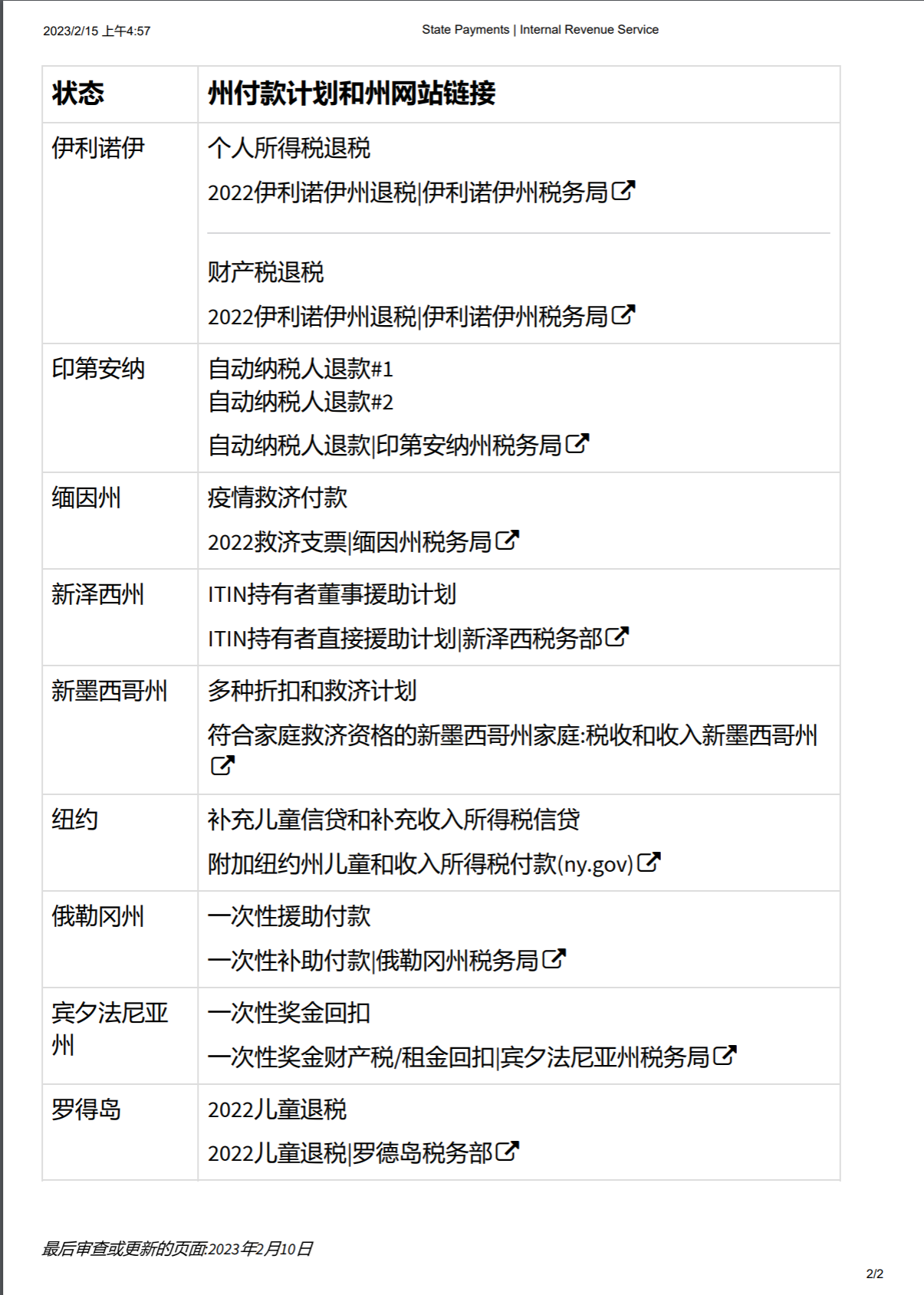美国国税局今天针对21个州于2022年所支付的特殊款项的联邦税状况,作出了详细阐述。
为了健全的税收管理和其它因素,国税局已确定许多州的纳税人无需在2022年的税表中申报这些款项。
在核查期间,国税局决定不会对一般福利和救灾相关款项的可征税性进行质疑。这意味着以下州的民众无需在2022年税表中申报这些州付款:加州、科罗拉多州、康涅狄格州、特拉华州、佛罗里达州、夏威夷州、爱达荷州、伊利诺伊州、印第安纳州、缅因州、新泽西州、新墨西哥州、纽约州、俄勒冈州、宾州和罗得岛。阿拉斯加州也在此组之列,但请参阅下文以了解更多详细信息。
此外,佐治亚州、马萨诸塞州、南卡罗来纳州和弗吉尼亚州的许多民众如果满足特定要求,从联邦税收目的出发,其州政府的付款不会算作收入。对于这些个人,如果付款是已支付州税的退税、并且收款人申请了标准扣除或逐项扣除但未获得税收福利,则从联邦税目的出发,州付款不包括在内。
国税局感谢纳税人、税务专业人士、软件公司和州税务管理者的耐心等待,让国税局和财政部可以来解决这一独特而复杂的情况。
国税局了解某些州涉及与2022年新冠疫情及其相关后果有关的特殊退税或付款的问题。各种州项目在2022年分发了这些款项,而围绕联邦所得税目的如何处理这些款项的规则非常复杂。虽然一般来说,出于联邦税收的目的,各州支付的款项可计入收入,但各州在2022年支付的许多款项也有例外情况。
为了帮助收到这些款项的纳税人及时报税,国税局提供以下附加信息。
已缴纳的州税的退税
如果付款是已支付的州税的退税,并且收款人申请了标准扣除或逐项扣除但没有获得税收福利(例如,因为适用了10,000美元的税收减免限额),则该付款从联邦税目的出发、不包括在收入中。
以下各州在2022年的付款属于此类,并且出于联邦税收目的将被排除在收入之外,除非收款人在扣除税款的那一年获得了税收福利。
- 乔治亚州
- 马萨诸塞州
- 南卡罗来纳州
- 弗吉尼亚州
一般福利和救灾款项
如果付款是为了促进一般福利或作为救灾付款,例如与新冠疫情相关,从联邦税目的出发,根据一般福利原则或作为合格的救灾付款,它可以从收入中排除。确定付款是否符合这些例外情况是一项复杂的、基于大量事实的调查,取决于许多因素的考量。
国税局复核了2022年各州可能属于这些类别的付款类型,考虑到出于联邦税目的确定这些付款处理方式的复杂的具体事实,以及目前试图提交联邦所得税表的个人所需的确定性和清晰度,国税局在两者之间进行了平衡后作出决定,为了健全税收管理的最佳利益,并且考虑到新冠疫情紧急状态将于2023年5月结束,这个问题仅适用于2022纳税年度,如果纳税人出于联邦所得税的目的未将其中一项付款的金额计入其2022年的收入中,国税局将不会质疑将2022年的付款视为可排除在原始或修正税表中的收入之外。
来自以下州的付款属于此类,国税局不会质疑在2022年从联邦所得税目的出发,将这些付款视为可排除在外的处理方式。
- 阿拉斯加州
- 加州
- 科罗拉多州
- 康涅狄格州
- 特拉华州
- 佛罗里达州
- 夏威夷州
- 爱达荷州
- 伊利诺伊州
- 印第安纳州
- 缅因州
- 新泽西州
- 新墨西哥州
- 纽约州2
- 俄勒冈州
- 宾州
- 罗德岛
有关此规则适用的特定款项列表,请参阅此图表(英文)。


其它款项
出于联邦所得税的目的,各州可能已经支付的其它款项通常包含在收入中。这包括阿拉斯加州永久基金分红的年度付款以及各州作为对劳动者的补偿而支付的任何款项。
IRS issues guidance on state tax payments to help taxpayers(英文版)
The Internal Revenue Service provided details today clarifying the federal tax status involving special payments made by 21 states in 2022.
The IRS has determined that in the interest of sound tax administration and other factors, taxpayers in many states will not need to report these payments on their 2022 tax returns.
During a review, the IRS determined it will not challenge the taxability of payments related to general welfare and disaster relief. This means that people in the following states do not need to report these state payments on their 2022 tax return: California, Colorado, Connecticut, Delaware, Florida, Hawaii, Idaho, Illinois, Indiana, Maine, New Jersey, New Mexico, New York, Oregon, Pennsylvania and Rhode Island. Alaska is in this group as well, but please see below for more nuanced information.
In addition, many people in Georgia, Massachusetts, South Carolina and Virginia also will not include state payments in income for federal tax purposes if they meet certain requirements. For these individuals, state payments will not be included for federal tax purposes if the payment is a refund of state taxes paid and either the recipient claimed the standard deduction or itemized their deductions but did not receive a tax benefit.
The IRS appreciates the patience of taxpayers, tax professionals, software companies and state tax administrators as the IRS and Treasury worked to resolve this unique and complex situation.
The IRS is aware of questions involving special tax refunds or payments made by certain states related to the pandemic and its associated consequences in 2022. A variety of state programs distributed these payments in 2022 and the rules surrounding their treatment for federal income tax purposes are complex. While in general payments made by states are includable in income for federal tax purposes, there are exceptions that would apply to many of the payments made by states in 2022.
To assist taxpayers who have received these payments file their returns in a timely fashion, the IRS is providing the additional information below.
Refund of state taxes paid
If the payment is a refund of state taxes paid and either the recipient claimed the standard deduction or itemized their deductions but did not receive a tax benefit (for example, because the $10,000 tax deduction limit applied) the payment is not included in income for federal tax purposes.
Payments from the following states in 2022 fall in this category and will be excluded from income for federal tax purposes unless the recipient received a tax benefit in the year the taxes were deducted.
- · Georgia
- Massachusetts
- South Carolina
- Virginia
General welfare and disaster relief payments
If a payment is made for the promotion of the general welfare or as a disaster relief payment, for example related to the outgoing pandemic, it may be excludable from income for federal tax purposes under the General Welfare Doctrine or as a Qualified Disaster Relief Payment. Determining whether payments qualify for these exceptions is a complex fact intensive inquiry that depends on a number of considerations.
The IRS has reviewed the types of payments made by various states in 2022 that may fall in these categories and given the complicated fact-specific nature of determining the treatment of these payments for federal tax purposes balanced against the need to provide certainty and clarity for individuals who are now attempting to file their federal income tax returns, the IRS has determined that in the best interest of sound tax administration and given the fact that the pandemic emergency declaration is ending in May, 2023 making this an issue only for the 2022 tax year, if a taxpayer does not include the amount of one of these payments in its 2022 income for federal income tax purposes, the IRS will not challenge the treatment of the 2022 payment as excludable for income on an original or amended return.
Payments from the following states fall in this category and the IRS will not challenge the treatment of these payments as excludable for federal income tax purposes in 2022.
- Alaska
- California
- Colorado
- Connecticut
- Delaware
- Florida
- Hawaii
- Idaho
- Illinois
- Indiana
- Maine
- New Jersey
- New Mexico
- New York2
- Oregon
- Pennsylvania
- Rhode Island
For a list of the specific payments to which this applies, please see this chart.
Other payments
Other payments that may have been made by states are generally includable in income for federal income tax purposes. This includes the annual payment of Alaska’s Permanent Fund Dividend and any payments from states provided as compensation to workers.




